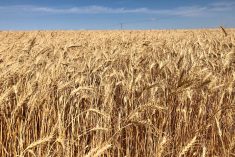Glacier FarmMedia—Winter crop production in Australia has been projected to increase nine per cent at 51.3 million tonnes for 2024/25. That’s according to the Australian Bureau of Agricultural and Resource Economics and Sciences which issued its latest supply and demand report on June 3.
As well, ABARES noted the higher production would also be nine per cent above the 10-year average of 47.0 million tonnes and come in as the country’s fifth-largest harvest on record.
In comparison, Australia’s summer crops are to reap 4.6 million tonnes in 2023/24, down 11 per cent from the previous year.
Read Also

U.S. grains: Soybean prices rise as China-U.S. truce assessed
Chicago soybean prices rose on Wednesday, recovering some of the previous session’s losses, as Beijing’s confirmation that it was cutting tariffs on U.S. farm goods put attention back on a trade truce between the countries.
ABARES pointed to improved conditions in the Queensland and New South Wales states for much of the greater winter output due to the above-average rainfall during Australia’s summer. The agency noted the autumn rains for the western parts of Victoria, along with South Australia and Western Australia were below average. Crops in those states will require sufficient rains in June for good germination and establishment.
The long-range weather outlook for the country called for a 40 to 60 per cent chance of above-average winter rains for Queensland, New South Wales, Victoria, and South Australia. There’s a 50 to 75 per cent chance for Western Australia to get above-average precipitation.
Coupled with Australia’s forecast for above-average output, ABARES projected planted area to reach 23.6 million hectares, which would six per cent greater than the 10-year average.
The country’s total wheat area is projected to bump up three per cent from 2023/24 at 12.7 million hectares. That’s to garner 29.1 million tonnes of wheat, which would make it Australia’s sixth-largest wheat crop. It would also be up 12 per cent from 2023/24 and 10 per cent more than its 10-year average.
Australia’s barley area is also to expand by three per cent at 4.3 million hectares, with its output projected to be 11.5 million tonnes in 2024/25 to be the fifth-best harvest. As well, it would improve on last year’s crop by seven per cent and be two per cent above the 10-year average.
Total pulse area is to rise 17 per cent at 2.5 million hectares, led by lentils at a record 885,000 hectares and chickpea area ballooning 80 per cent at 730,000. ABARES forecast lentils at 1.6 million tonnes, which would be about the same as the previous harvest, and 10 per cent greater than the 10-year average. Chickpeas are to come in at 1.1 million tonnes, skyrocketing 133 per cent from 2023/24 and 46 per cent above the 10-year average.
On the downside, the country’s canola is to contract nine per cent in 2024/25 at 3.2 million hectares due to reduced financial returns with farmers switching to the above crops. Australia’s canola output is to drop five per cent from last year at 5.4 million tonnes, but as the fourth-largest crop, it’s to come in 21 per cent above the 10-year average.











